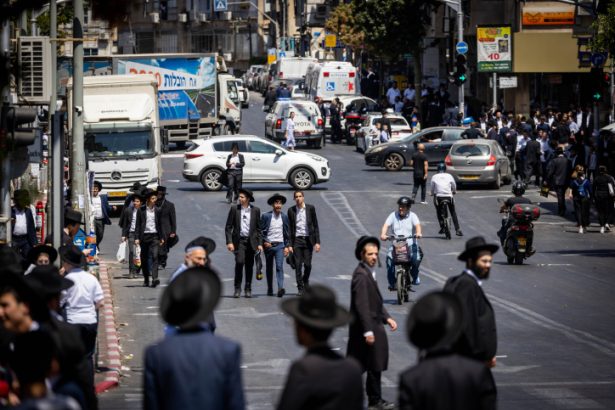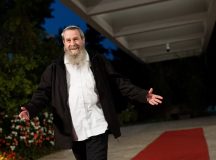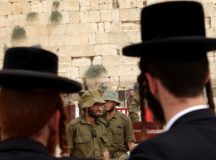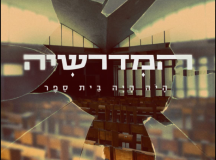Daniel Goldman is a businessman, social activist and a former chair of the Coalition for Haredi Employment, Gesher and World Bnei Akiva. In this review essay he reflects on three authors’ respective interpretations of the challenges facing Israel and its Haredi community as the community grows in both size and influence.
Three young Haredi authors have made important contributions to the crucial conversation about the future of Israel’s Haredi communities and their increasing influence on the future of Israel itself. In Israel’s Future With an Ultra-Orthodoxy Majority (2002, Yediot Ahronoth, pp.354), Yitzik Crombie combines a potted history of Haredi-ism and its Israeli variant and a diagnosis of how the growing population of Haredim will affect Israel economy and security. Crombie draws on many years of experience as a social entrepreneur successfully working to integrate Haredi men into the innovation economy. In The Haredi Communities in Israel: Ideology, Reality and Human Rights (2022, Bialik Institute, pp. 320), Dr Aharon (Ari) Eitan takes a more philosophical approach in considering how Haredi-ism should be renewed in order to facilitate the other changes required for the successful economic and social integration of Haredim into Israel society. Finally and most recently, Rabbi Dr Benayahu Tevila has released Haredi Yeshiva High School (2023, Resling, pp.280), in which he sets out the historic and religious background for the type of hybrid combining the best of Talmud studies and secular studies within the Israeli Haredi context, a topic he has actively promoted during a ten-year career within the Israeli Ministry of Education.
Although Crombie presents his book based on some future reality of the Haredim becoming the majority in Israel, the scenario he describes based on the current demographic, political and crucially economic trajectories will reach boiling point much sooner. Given the raised tensions in Israel at the moment, that point may indeed not be far off.
Crombie grew up in a Chabad Lubavitch community, considered to be a more marginal Haredi group, historically more open to the outside world and to secular studies. However, his book reads more classically like an ‘official’ Haredi narrative. Eitan, who grew up in a more classic Haredi household, takes a more radical approach of moving the Haredi narrative to one based on individual human rights [1] (the absence of basic education undermines a Haredi’s ability to fully express themselves) that would sound foreign to most Haredi ears. Tevila meanwhile is a product of the classic Haredi Yeshivot and is an alumnus of the Slobodka Yeshiva, the heads of which are now considered be the leaders of the ‘Litvak’ Haredim [2] in Israel following the recent passing of Rabbi Gershon Edelstein.
In some ways this is a good reflection of the paradox facing Haredi activists trying to meet the community’s challenges and those of Israel society as the Haredim grow more dominant demographically. Around 1950, the Haredim constituted approximately 3 per cent of the total population. By 2009 they had grown to 10 per cent, and they currently form 13 per cent of the population. According to demographic analysis performed by Israel’s Central Bureau of Statistics, the expectation is that they will form 16 per cent in 2030 and over 30 per cent by 2065. One amazing statistic to consider is that over 60 per cent of the Haredi population is under the age of 20, making it one of the youngest populations on the planet. Whereas the general population growth rate for Israel is ~2 per cent per annum, the Haredim community is growing at 4 per cent.[3]
‘Noah’s Ark’ and Torah-only Study for all
Eitan claims that there are two principles that define the leadership’s response to the burning questions in the public debate. The first principle is defined as “Noah’s Ark”, ‘this due to the emphasis on the need for a maximal protection from the influence of the modern-secular world.’ The second principle is “Torah-only study for all’, ‘the value that drives the system to channel all the male children and adults to a life of exclusive Torah study as their occupation as the primary ideal, which is where the definition “a society of learners comes from.”’ It is these two principles that Eitan uses to describe the Haredi response to army service, employment and education. It is these principles which create an aggressive tracking into certain types of educational institutions that creates the denial of human rights that Eitan describes later in the book as a basic in a liberal democracy: ‘one of the central aims of education is defined within the philosophy of education as “individuation” or “autonomisation.”’ On the face of it Eitan is on strong ground as these principles are included in Israeli law with respect to the role of the education system for all Israeli children. The extent that this is achieved in non-Haredi schools may be worthy of debate, but to create a document that is meant to drive internal support for change in the system, based on the philosophy of liberal democracies and human rights, is likely to hit a brick wall. Even more modern and open-minded Haredim will have difficulty stomaching the argument.
Tevila approaches the justification for secular studies – integrated or alongside Torah study – from a completely different angle. Using a more historic analysis he presents examples of leading Haredi Rabbis from the past and examples from outside Israel in the present to make a ‘Haredi’ argument. Whilst this is not without controversy among Haredi leaders and politicians, I believe the argument will help give more confidence to Haredi families that their choice (of learning core subjects rather than just Torah) is authentic and keeps them within the Haredi fold. This is a key, if not the key benchmark for most members of the community. Tevila even finds an intriguing quote from Rabbi Menachem Eliezer Shach (1899-2001), the hugely successful second-generation leader of the Litvak Haredim in Israel, who is credited for the massive success of rebuilding the Yeshiva world post -Holocaust. It goes without saying that he was against the creation of Haredi Yeshiva High Schools (which include both Torah and core subjects), as a matter of policy.
At the same time, he had surprising praise for the alumni of such schools. In his book, Tevila describes a conversation between Rabbi Shach and another prominent Haredi Rabbi, Shomo Hoffman. According to Hoffman, Rabbi Shach:
always remarked on two positive traits of the alumni of Haredi Yeshiva High Schools – one that they manage their time carefully, and that they have logical and organized thought. He describes that their time management is due to their need to prepare for exams, which the regular yeshiva students do not have, and credits the study of maths for their logical and organized thought… in maths, if you miss one number, then the entire calculation will be off. This is not the case with Talmud, it is possible to present one answer to the Talmud’s question, and then deny the first answer by presenting a second logical possibility, but without the need for a clear proof which is correct, and hence the yeshiva student is less used to logical and organized thinking.
A remarkable admission for the Rosh Yeshiva of Ponevezh to make.
Resistance to Change – A Religious Value
Today’s Israeli Haredim are resistant to change not only because they are a conservative religious community, but due to their belief that change itself has negative theological implications. As such the very changes that Eitan calls for tend to be immediately rejected by the mainstream. Indeed, the leadership are caught between the changing needs of the community and the imperative to slow the changes to a minimum. Tevila too will come under attack, even though he is not calling for the classic Yeshivot without any secular studies to be replaced, but simply trying to establish the Yeshiva High School as an authentic alternative. Any threat to the status quo, especially in education is taken very seriously by the mainstream leadership.
Although the books were written without the perspective and effects of the new Netanyahu government, one cannot read them without considering the current political backdrop, and how its policies may influence the theses presented by Crombie, Eitan and Tevila. The subject of the future of Israel, and how the development of the Haredi communities will impact its future is a vast and complex topic. Indeed there are those who have started to question whether regardless of any recommendations of these authors being implemented, Israeli society is heading towards an inevitable collision, long before the Haredim become a majority.
History of Separation Remains Dominant Haredi Ethos
In 1912 the religious and communal response to modernity became a larger political issue with the increasing emergence of political Zionism over the Jewish world. Having previously focused on battling against individual enlightenment and secularisation, the Haredi world was then faced with a new challenge in Zionism. This new national Jewish movement won support from parts of the religious community while large parts of the Rabbinic leadership saw the ideology as a new and serious threat. The Zionist project was a national, not private, project and its secular leaders saw it as a creation of a new Jew freed from religious commitment. Just the sort of ‘redemption’ Haredi leaders would have to respond to. And thus, the religious response became political with the forming of Agudat Yisrael as a protest against the emerging force of the Zionists. This reactionary movement, formed in protest to modernity, secularisation and political change is something with roots and history, crucial to understanding the Israeli Haredi narrative and stance in 2023. The same unanswered dilemmas of how secular Zionism and Haredi-ism can accommodate one another from the founding of the State still dominate the public discourse, and have been amplified with the widely criticised new coalition agreements [4] and the eruption of the anti-judicial reform protest movement.
Crombie develops an idea that separation and even social isolation is an ethos that has developed over 3,000 years. And here it’s worth asking whether this is a core Jewish value? And is it relevant to all times and all places? If it is a response to modernity and the dangers of secularization and assimilation, what does this mean for Haredim and Israeli society in which a) assimilation is no longer relevant in the Jewish State, and b) they are becoming an increasingly important and many would say powerful part of the political structures with influence over the course of the country and not just their own community.
These two questions go to the heart of what Crombie is asking. In other words, what will the Haredi community look like as it grows from small minority to large minority and then perhaps to an actual majority? Clearly the risks and opportunities that are raised in the book will need to be addressed long before Haredim form the majority of Israel’s citizens, hence the timely publication. Its importance is amplified in the light of the return to government of the Haredi political parties, and the likely affect this is going to have on policy over the coming years.
In a recent panel discussion as part of the launch of Crombie’s book, MK Yitchak Pindrus of United Torah Judaism, an erudite and forceful spokesperson of the official Haredi point of view, commented that we shouldn’t consider Haredi-ism in strictly religious terms, but more a social framework created to protect a very specific and demanding form or religious Judaism. He argued that the more they sense the fences surrounding the community under threat, the more likely they are to ‘circling the wagons’ as a political response. This explains from his perspective the fight against the use of the Internet (filtered or otherwise) or the total control of their own autonomous education system. Eitan takes this theme as one of the central ways to explain the sociology and politics of the Haredi community and makes a convincing case that this is one of, if not the leading driver in relations between Israeli Haredi-ism and wider Israeli society and establishment. Whether or not Crombie’s argument is sound from a historic point of view, there is no doubt that it remains a key foundation of the Haredi communities in Israel.
Crombie describes the dire situation of Haredi non-Torah education for boys and is clear that without serious change the community’s ability for successful economic integration will be limited. However, he falls short in pushing for a major overhaul as a key milestone in preparing them to be in the majority. Instead he expands on his thinking around vocational training. Crombie himself is fully aware that in the arena with which he is most familiar – training Haredi men for work in Israel’s high-tech sector – the two best ways of being successfully employed are via serious academic study in computer science or military service in a technology unit. However there remains little progress in either the community or the government promoting these routes.
Secular Studies as a Lens for Reading the Torah
In a certain way the dilemma of the father of Haredi Judaism, Rabbi Moses Sofer, known as the Chatam Sofer, founder and head of the famous Pressburg Yeshiva, remains the exact same dilemma for the Israeli Haredi community in 2023. One of the outstanding scholars and Rabbinic leaders of his generation, it was Sofer who first responded to the threat of modernity when he coined the phrase ‘New (Hadash) is forbidden from the Torah.’ The classic use of this dictum was in a specific and limited case around agricultural harvests in the spring time, but was interpreted by Rabbi Moshe Sofer to mean ‘new’ as any change in custom or law. Ironically this was a radical use of the phrase, but has become the foundational idea for conserving Judaism in the ongoing struggle against the influences of modernity and secularisation which at the time of Sofer was driving major changes to Jewish ritual and law. Ironically, this great rabbi was a serious student of secular studies, as Crombie describes:
He was an expert in mathematics, astronomy, history, philosophy, anatomy, French and German. He believed that worldly wisdom is a gateway to the Torah and instrumental to its understanding, and initially even included secular studies into the Rabbinic training school that he tried to establish with David Friesenhausen, himself a maskil.[5] But once the Reform movement spread and he became concerned that the sciences would become a tool of secularisation, Sofer withdrew his support for secular studies and objected to their being part of the curriculum.
So far as Sofer was concerned, even though secular subjects were very much integral to his understanding of Torah, compromising on not studying them was a price worth paying in order to protect future generations of religious Jews and Judaism itself. Tevila dedicates an in-depth analysis of the controversy that remains part of the internal Haredi debate on education and whether secular studies can or should be included. He quotes extensively from Rabbi Elchanan Wasserman (1874-1941) a leader of the Haredi movement in Europe between the wars, and Rabbi Yosef Hayim of Baghdad (1835-1909), both of whom had made different but broadly positive statements about the possibility of a secular education in parallel to a Yeshiva education. In addition, Tevila notes that secular learning in Yeshiva High Schools in the large Haredi communities in the Diaspora (UK, France and of course the US) are an acceptable part of the educational spectrum and the alumni are not considered any less Haredi, indeed in many parts of the community this is the dominant form of education.[6]
Borrowing the term from Professor Yosef Gorny, Tevila notes the existence of Haredi ‘public thought’, or one might say public consciousness. The claim he makes is that as much as the majority Rabbinic position of the Haredi community was against secular studies in yeshivot for boys, it was solidified and turned into a major taboo by publicists who persistently wrote on the topic in the Israeli Haredi media. If we think of the Haredi state of mind in the broadest sense, the use of media as a way to buttress cultural standards and norms has been absolutely crucial. The very creation of the official Haredi newspapers is not for the traditional reason of the right of the public to know, but to shape and protect the ‘correct’ public opinion or thought.[7]
In 2023 the State of Israel and the Haredi leadership remain in the same loop. Sadly, there are few voices within the Haredi community who would accept that secular studies have a substantive contribution to how we best understand Judaism and the Torah, or on how mathematics and philosophy could actually enhance religiosity. This is what makes Tevila’s contribution interesting. Without Tevila’s approach, it has, at best been reduced to a debate around whether economic necessity and future employment opportunities would be benefited by wider integration of secular studies within the Haredi education system. Even without the more philosophical debate around the inherent value of studying the sciences as a religious Jew, the level of acceptance or support for secular studies remains one of the key points of tension between Haredim and the rest of Israeli society. As long as there is widespread belief within the Haredi community that they already make a meaningful economic contribution – at least as important as their secular peers – the reality of becoming an increasingly significant part of the population will not in their minds create an economic crisis, and therefore will not create significant motivation towards change.
‘If it ain’t broken, don’t fix it’
In discussions with researchers[8] on attitudes across the various Haredi communities there is little recognition or urgency around the question of secular studies as a gateway to future academic or employment opportunities. Rather the internal Haredi narrative remains that Haredi society is already a net contributor to the Israeli economy. Some Haredim even believe that their contribution is greater than their secular peers. Without an ability to connect between the macro-economic outcome for the country, or the effect that a future lack of doctors may have on the health system, it is hard to see how any of these books will make a meaningful dent in the motivation of Haredim to adapt their education accordingly.
This narrative or awareness is not created by accident, but the result of the messages Haredim receive from their leadership, with repeated claims that it is Torah study that protects the IDF, not the IDF that protects Israel’s citizens. This is just one trope. During COVID, the then Great Rabbi of the Haredi community Rabbi Chaim Kanievsky ordered the schools to remain open, because halting Torah study was a greater risk than the virus itself.
Interviewed at a conference arranged by the Israel Democracy Institute at the end of December, Pindrus made the rather dramatic claim that ‘The secular public in Jerusalem lives at the expense of the ultra-Orthodox and not the other way around.’ This flies in the face of repeated research analysing the economic contribution of Haredi families relative to non-Haredi families. Indeed, the day before the conference a report was published in the Calcalist [9] showing the dramatic gap in tax payments and receipts of the average Haredi family. This formed part of a series of articles, published during the coalition negotiations. Pindrus is not alone in making provocative statements about Israel’s economic situation. New Haredi member of Knesset, Yitzchak Goldknopf, the leader of the UTJ, responded to concerns that a growing Haredi population with basic (and in some cases non-existent) mathematics and English would be a strategic problem for Israel’s economy. In an interview on Israel’s leading news channel, he said ‘I haven’t noticed that mathematics has advanced Israel’s economy’ and went on to claim that the economy would actually be better if Haredim were in charge. The return of the Haredi parties to government as a result of the recent elections has seen some clear policy choices, and as of now none of the proposals move the needle towards more general studies for the Haredi boys, and increased academisation for the women.
These are of course just examples of a deeper sense of awareness the Haredi community has, or indeed does not have with respect to the consequences of them becoming a much more dominant part of the population. What will happen to the health system[10], the universities, Start-Up Nation and of course national security? The inability or lack of desire to see the connection may be a crucial block to an internal motivation for change.
Netanyahu and the Haredim
Prime Minister Netanyahu has built a very deep and long-standing political alliance with the Haredi parties. They have become a natural, almost presumed coalition member for every Netanyahu government bar one. It is worth spending a moment to consider the history of this relationship.
The Haredim have been partners in almost every Israeli government coalition since the right came to power under Menachem Begin in 1977. In the intervening 46 years the left has rarely returned to power with the notable exceptions of the Rabin and short-lived Barak governments. Aside from them it has been right, national unity or centre-right (Olmert, Sharon, Bennet-Lapid).
In 2003 Netanyahu was Finance Minister under Ariel Sharon and part of a coalition that included Yair Lapid’s late father Tommy Lapid. This government became infamous in Haredi circles because of historic economic decisions made by Netanyahu following the double economic crisis of the Second Intifada and the global downturn after the bursting of the dot-com bubble. Netanyahu suffered huge political backlash and damage from Likud’s Haredi partners, and one of the personal political conclusions Netanyahu subsequently reached was that he must never again put that partnership at risk. Professor Nissim Leon, in a soon to be published article, describes this process in detail and it’s worth noting that in the later Netanyahu-Haredim political alliance the relationship that started as functional, has morphed into something much deeper. The effect of growing Haredi demography alongside the community’s inevitable integration within the economic and political structures of the state, has not only changed the Haredi community (what Professor Kimmy Kaplan calls Israelisation) but has also rubbed off in the other direction. There is now increasingly deeper ideological convergence between right wing parties and public on the one hand and Haredi parties and public on the other. This is expressed in wide agreement on previously ‘narrow Haredi’ issues of (non)-military service for Haredi men and elevating the importance of Torah study, even at the cost to the defense and economic requirements of the State and society.
This is the prism through which to consider the huge financial commitments that the current Netanyahu government has made to the Haredi parties, adding hundreds of millions of Shekels to the Haredi education system, and specifically to parts of that system that refuse to integrate or support secular studies. This in addition to the increase in the monthly stipend for Haredi adult men in full-time Torah study and disincentivising them to join the workforce.
Everyone fearful for the future success of the Israeli economy and so many other core aspects of Israeli society will only be more anxious in light of these coalition agreements. No doubt that as the pandora’s box of issues opened with mass protests against the proposed legal reforms, the country’s future with a growing Haredi population has also become one of the protest movements targets[11].
Both Crombie and Eitan suggest ways forward for the Haredi community to think in more strategic or macro terms about their role within Israeli society. An optimistic approach would see the dynamic that Crombie is driving from the inside and Eitan from the edges of the Haredi community as generating the organic type of change that can prepare the Haredi communities for the twenty first century. Tevila describes a type of Yeshiva education that has grown significantly in the last 10 years and could, if allowed to flourish, be a source of successful Haredi professionals. However, and this is crucial to remember, the current data and trends show us that the changes occurring are still sub-critical mass, and none of those researching the community can say when this passes the tipping point when positive role models and communal and educational infrastructure will be strong enough to self-sustain and support the change.
Ultimately the importance of Crombie’s book will be measured by its potential impact within the mainstream, in terms of challenging assumptions and status quo, whereas Eitan’s book will be successful if it sparks leadership from within the more modern Haredim seeking to lead Haredi society into the twenty first century. Tevila has picked one of the most sensitive topics within the community, the idea that Haredi high school students can combine secular and Talmud studies.
Policy makers, philanthropists, and most importantly activists like Crombie, Eitan, Tevila et al, have no choice but to continue to work with different parts of the community to build positive momentum. None of this need to come at the expense of any individual’s Haredi identity, but if the trends predicted by most of the economists continue to strengthen we may reach a point of social or political conflict long before Haredim become the majority in Israel.
Perhaps irrespective of the content, the fact that three young Haredi activists have published serious books looking to address internal Haredi questions, and the tense topic of relations between Haredim and the rest of Israeli society is a something itself to be optimistic about.
[1] Eitan makes a case that the reason the education system should be changed is because it denies Haredi children – and the boys in particular – their basic human rights and the type of (non-core subject) education they receive denies them the basic capability of realising themselves.
[2] There is no formal process for choosing the leader of the Haredi community, and unlike the Hasidic communities where the leadership is broadly passed down as a dynasty, the Litvak community has no clear transfer of Rabbinic power. At this point in term most observers would agree that Rabbi Dov Landa is now the at the head.
[3] For a useful summary see – https://en.idi.org.il/haredi/2022/?chapter=48263
[4] The budget passed by the Israeli government in May has come in for widespread criticism from economists and commentators. One of the core themes of the criticism was the increased funding for the Haredi education system. Kohelet, the very organisation that has been at the centre of the legal reforms published a damning commentary, https://en.kohelet.org.il/publication/the-economic-effects-of-the-coalition-budgets, as did the New York Times https://www.nytimes.com/2023/05/24/world/middleeast/israel-netanyahu-budget.html
[5] Maskil is the term for a Jewish Enlightenment intellectual, unusually Friesenhausen was an Orthodox Maskil who combined being a Rabbi with being a secular intellectual. https://en.wikipedia.org/wiki/David_Friesenhausen
[6] An important exclusion to this would be the Hasidic communities who have been in the news in London and New York because of the lack of secular studies, often in apparent violation of the law of the land.
[7] The Medium Is the Definer: Daily Journalism as a Tool for Forming Community: A Case Study—The Ultra-Orthodox Community in Israel, Eli Friedmand and Tsuriel Rashi, Religions 14:650 (2023),
[8] As yet unpublished data regarding Haredi attitudes to Israeli society.
[9] Based on data from the Central Bureau of Statistics and Finance Ministry, financial daily Calcalist reported on Tuesday that just under 90 percent of all tax payments were made by non-Orthodox Israeli Jews while members of the Haredi community only contributed 2 percent of all income tax payments – despite comprising 7 percent of Israeli households. According to the report, secular Israelis pay nine times more in income tax and six times more in overall tax than their ultra-Orthodox counterparts, many of whom eschew full-time employment for lifetime study in a kollel, a yeshiva for married men.
[10] Recent research highlights the possibility for crisis within the Israeli health system, with very low (almost zero) participation rates for Haredim being on core issue. In order for there to be a pro-rata of Haredi doctors within the system tens of thousands of Haredim would have to train as doctors. Without core general studies, not to mention motivation, this is going to be a mountain to climb. Treister-Goltzman, Y., Peleg, R. The physician shortage in Israel and a policy proposal for improvement. Isr J Health Policy Res 12, 2 (2023). https://doi.org/10.1186/s13584-023-00552-1
[11] One of the components of the protest movement – ‘Brother in Arms’ marched through the main Haredi city of Bnei Brak to highlight that fact that the vast majority of Haredi men do not carry out any army service. https://www.timesofisrael.com/thousands-march-through-haredi-enclave-bnei-brak-as-day-of-protests-ends/





































Some of these Hatam Sofer arguments are torpedoed by the very adeptness with which the Haredim use mobile phones and white goods and abuse the welfare.
They are not allowed to behave like gentry screwing rent out of society elsewhere and claim to work prosperously in US and elsewhere.
So it is to be hoped that one way or another they do fit into Israel’s economy sooner than later because if the Israel goes bankrupt as the secular half leaves they might find themselves at the mercy of the similarly narrow minded Hamas Arabs – unless the learn to fight in uniform.